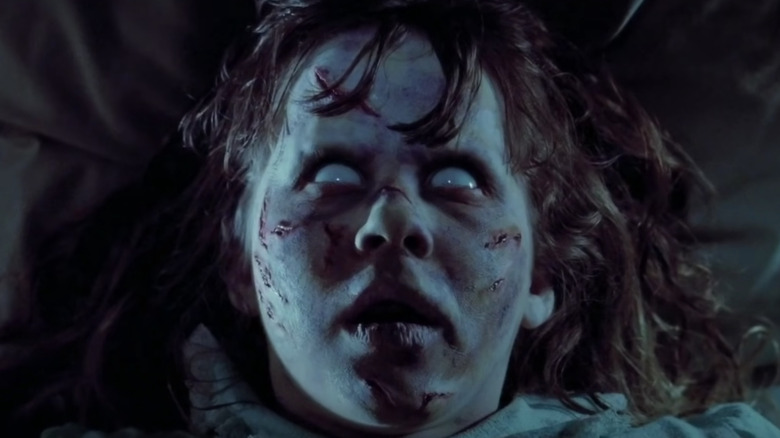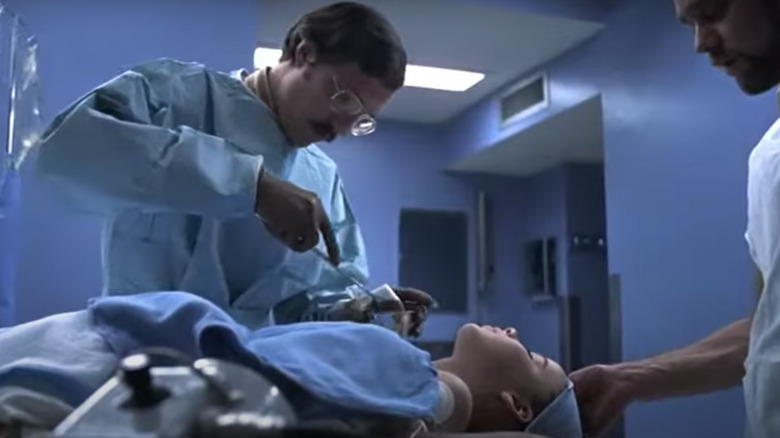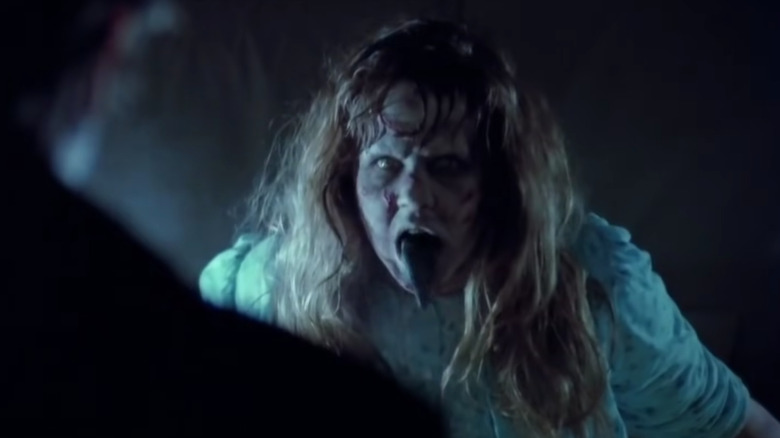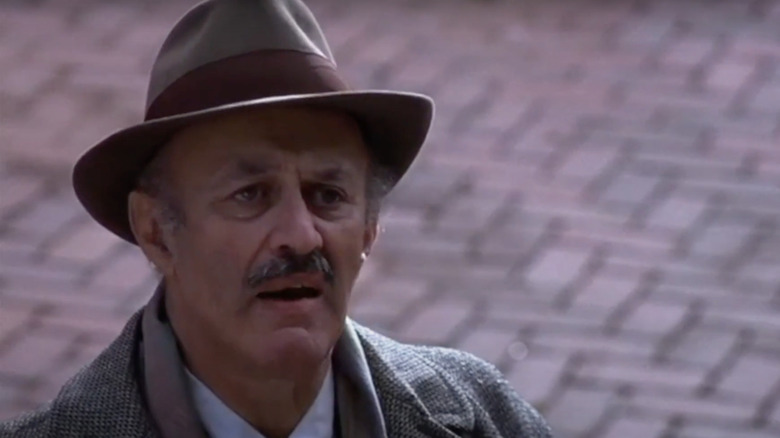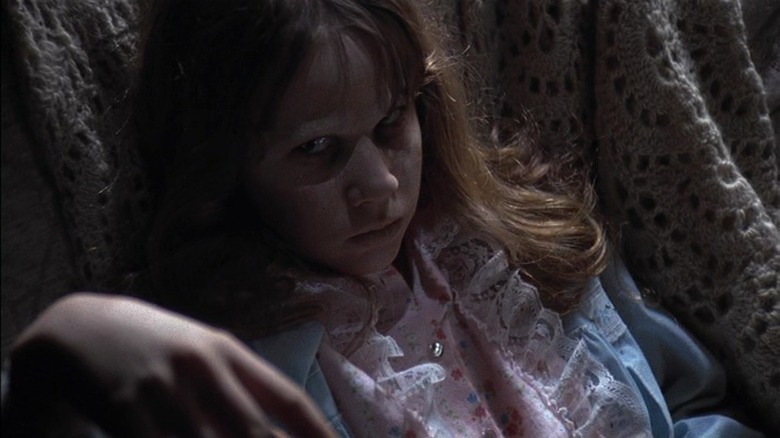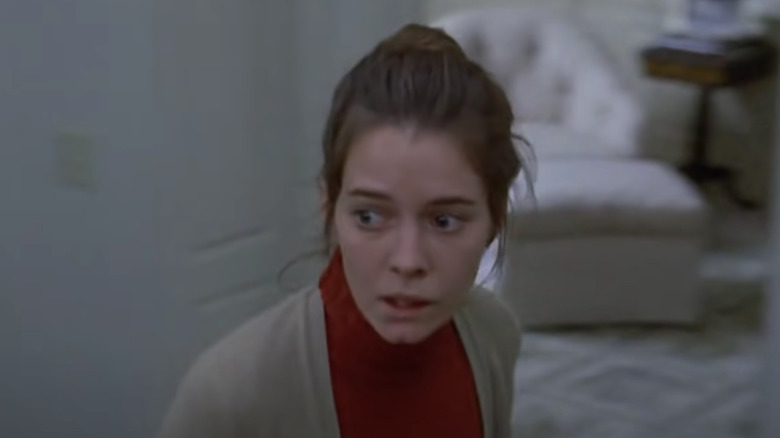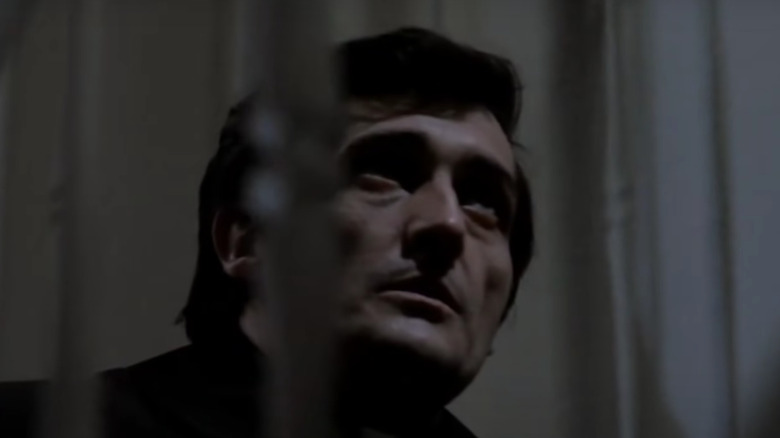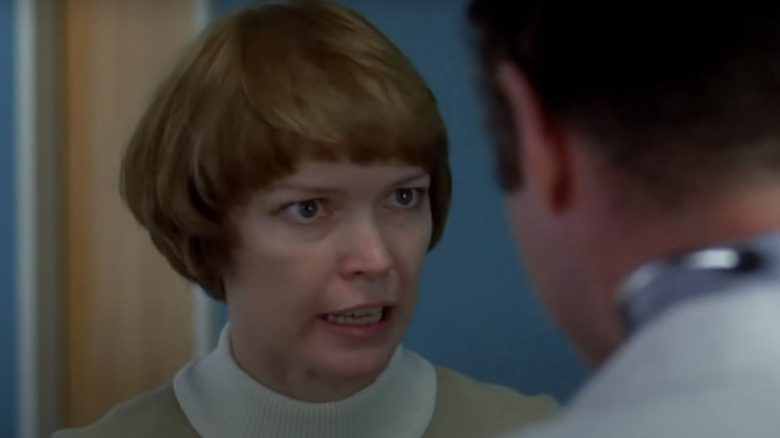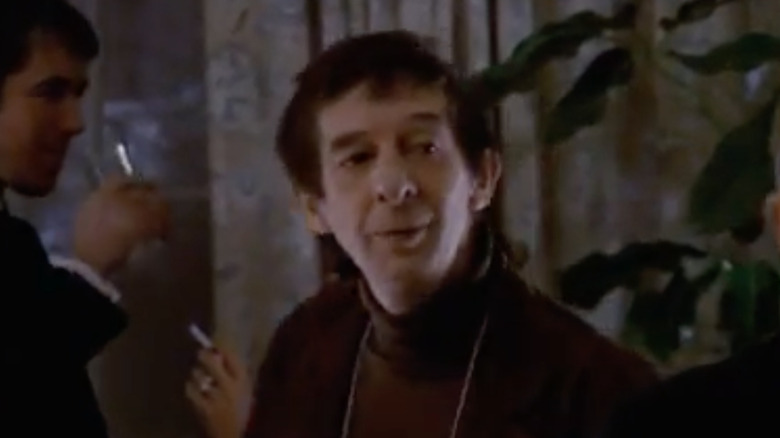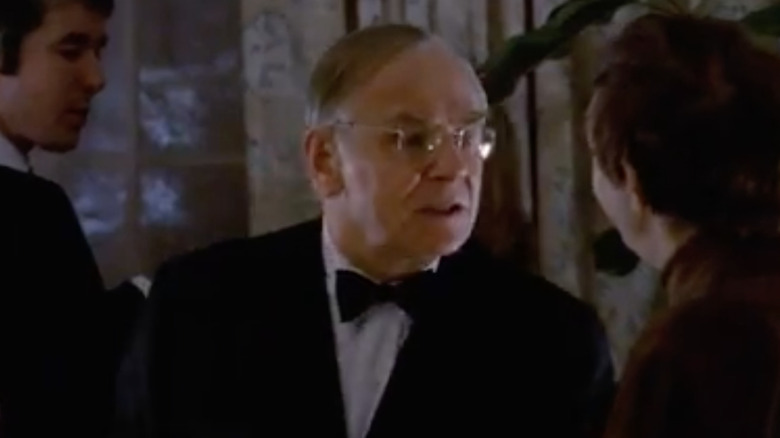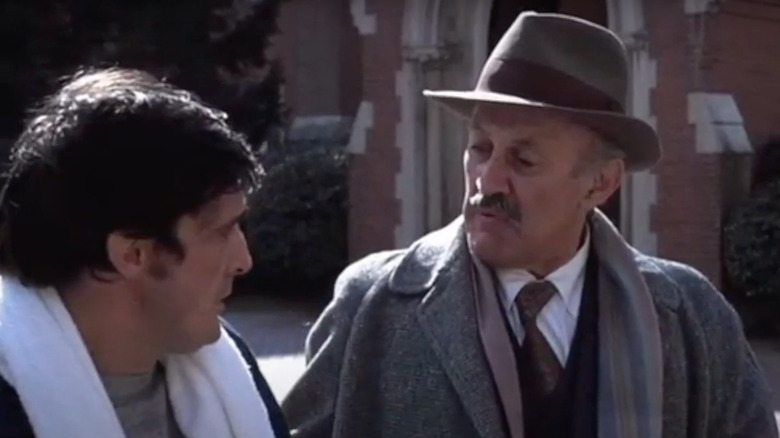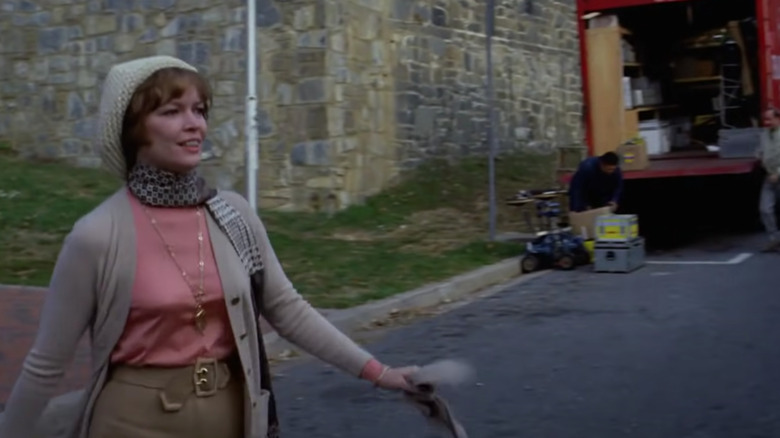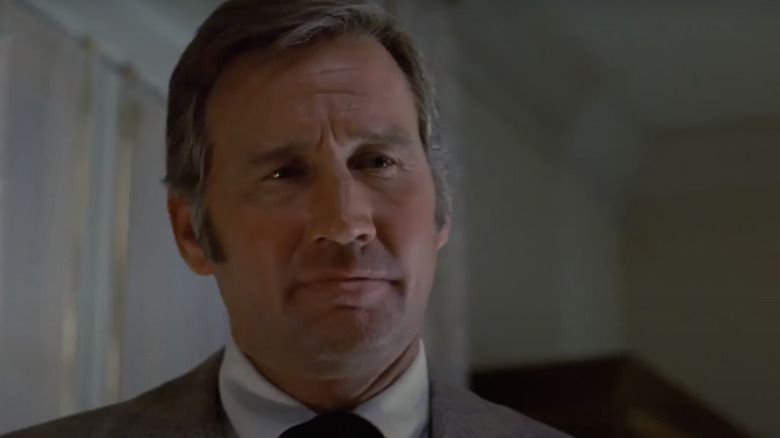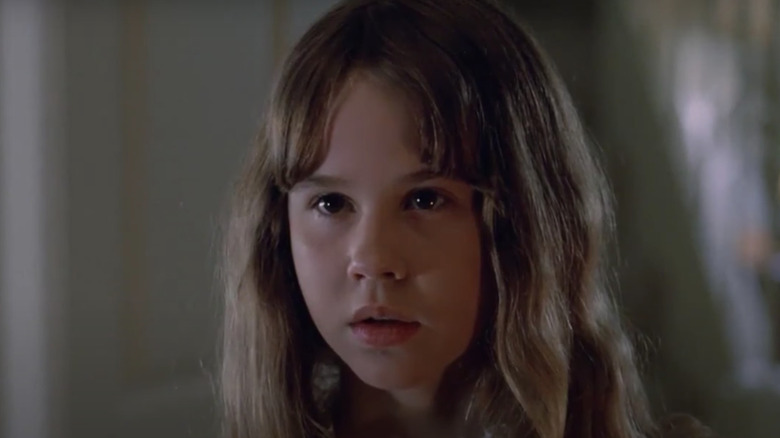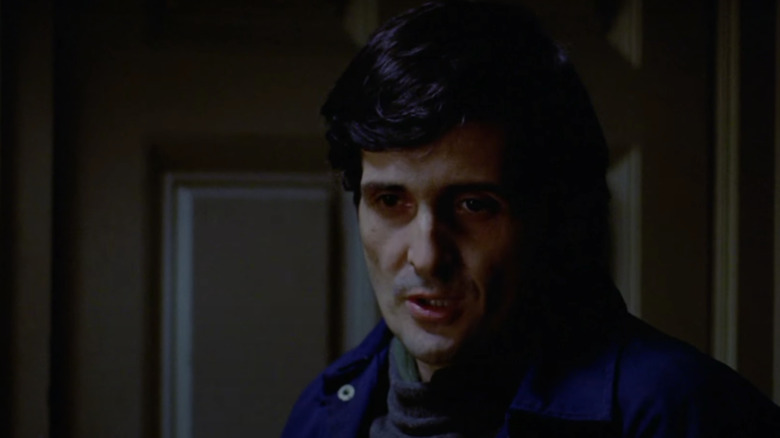How The Exorcist Differs From The Book
We may receive a commission on purchases made from links.
There are many excellent horror films out there that could be considered in the running for the title of "the scariest." While the matter is subjective, few films can stake as large a claim on the title as "The Exorcist" from 1973. The film proudly declares itself "the scariest film of all time" on some posters and is routinely named the best horror film ever made.
After winning the Academy Award for Best Director for his 1971 crime film "The French Connection," William Friedkin made "The Exorcist" as his next movie. His efforts landed him another Best Director Oscar nomination alongside a staggering nine additional Academy Award nominations, an extreme rarity for the horror genre. The film took home the Oscars for Best Sound and for Best Adapted Screenplay. William Peter Blatty wrote the novel "The Exorcist" and then adapted his own work when writing the screenplay and winning the Oscar. Blatty was no stranger to screenwriting, having earlier written movies like the "Pink Panther" sequel "A Shot in the Dark."
Given that the original author of the source material returned to write the screenplay, it makes sense that "The Exorcist" is quite a faithful film adaptation. Even still, there were a number of significant changes made between the book and the film. Here are the biggest ways that "The Exorcist" movie differs from the original novel.
The film streamlines Reagan's medical treatment
12-year-old Reagan MacNeil (played by Linda Blair in the film) is the little girl who gets possessed by a demon and requires an exorcism. In the film version of "The Exorcist," Reagan's mother Chris, who is an atheist, seeks out medical treatment for her daughter before requesting an exorcism. The book follows a similar train of thought, but spends far longer exploring different medical explanations and possible treatments for Reagan's disturbing ailments.
In the book, these medical tests and treatments are an ongoing part of the characters' lives for a much longer period of the time, with Reagan visiting a whole slew of different doctors and hospitals both nearby and out of state for specialist observation. The medical procedures that are shown in the film are kept brief but are memorable due to the stark realism they are presented with by director William Friedkin, who began his career by making documentaries. The film managed to neatly streamline this element of the novel without eliminating it entirely, something William Peter Blatty showed a knack for with many elements of his adaptation.
The film strips away ambiguity
The book version of "The Exorcist" spends the vast majority of its length — arguably its entire duration — maintaining a level of ambiguity as to whether or not Reagan is truly possessed. In the film version, it becomes clear relatively early on that Reagan is possessed. Seeing the supernatural, demonic happenings with one's own eyes strips away much of the ambiguity and mystery found in Blatty's prose.
No matter how extreme Reagan's ailments may be or how supernatural her actions may appear, the novel goes to great lengths to always offer a possible alternative explanation outside of possession. The alternatives may sound far-fetched, but they are presented as having a basis in science, and characters even offer real-world case studies of similar unexplained phenomena happening around the world. In the book, Reagan might be possessed by a demon, but then again there's always a slim chance that she is instead afflicted with severe physical/mental ailments. By the end of the book, the odds certainly seem in favor of the possession being genuine, but the door was left ever so slightly open for it to have been a medical anomaly instead. As noted by The Washingtonian, Blatty was sure to always balance out the potential supernatural happenings with the "matter-of-fact minutiae of a clinical case study" and "a backdrop of solid theology."
Lt. Kinderman was a larger character in the novel
Lt. William Kinderman, the detective investigating the death of the filmmaker Burke Dennings, was a much larger character in the novel. In the film version of "The Exorcist," Lt. Kinderman is a supporting character, but he was one of the three primary protagonists of the book. Some chapters even follow his perspective. In addition to having his role reduced between the novel and the film, Lt. Kinderman also had his personality tweaked. He is a much goofier and affable sort in the novel à la the popular TV detective "Columbo." This similarity to "Columbo" is actually what led to his personality being somewhat though not entirely watered down for the film. The "Exorcist" novel and "Columbo" were both released in the same year, 1971.
Since his novel had been making the rounds after being sent out to his publisher ahead of release, William Peter Blatty was convinced that the creators of "Columbo" got ahold of his unpublished material and ripped off his Lt. Kinderman character when creating their own detective character. In a 1990 interview with Fear Magazine, Blatty said "I feel quite strongly that Columbo ripped off Kinderman. There's very little doubt in my mind." He also said that he even had plans to create his own detective series following the Kinderman character but pulled the plug following the success of "Columbo," as many accused him of ripping off "Columbo" when writing the Kinderman character instead of the other way around. For their part, the creators of "Columbo" denied any claims of theft, and although the series officially premiered in 1971, the original 94-minute-long pilot was first broadcast in 1968.
Explicit content
Part of what makes "The Exorcist" such a terrifying film is the shocking extent of its explicit language, blasphemy, and violence involving a 12-year-old girl. Some of the most disturbing scenes involve the possessed Reagan acting out in aggressively sexual ways such as masturbating with a crucifix and shoving her mother's head in between her legs while screaming "lick me!" As shocking as those scenes were and remain today, the book pushed the explicit content even further.
Of course in the film version of "The Exorcist," with a real young actress in the role (Linda Blair was 14 at the time of the film's release), certain lines needed to be drawn, particularly in regards to the demon's sexual acts but also in regards to its most explicit language. Those limitations did not apply to William Peter Blatty's Prose in the novel. One recurrent tactic of the demon to humiliate and torment Reagan and Chris MacNeil in the book is to make Reagan commit sexually explicit acts and speeches in front of company.
Sharon was a much bigger character in the book
Sharon, played by Kitty Winn, is a minor character in the film. She works as an assistant to Chris MacNeil and helps out with caring for Reagan. In the film version of "The Exorcist," Sharon can be found in scenes taking place at the MacNeil household and having small interactions mainly with Chris and Reagan, but she is a much more prominent character in the book — one who is more directly involved in the plot and who has a more distinctive personality.
A great deal of drama is generated in the novel from the difference in opinion regarding religion between Sharon, a Christian, and Chris, an atheist. Chris and Sharon have a friendly relationship as employer and employee, but there is friction between them when Chris learns that Sharon has been telling her daughter about God and the afterlife, subjects Chris has largely avoided with Reagan. Because of her religious beliefs, Chris suspects Sharon of being the one to place the crucifix under Reagan's pillow while questioning others in the household as well. In the film, Chris only accuses Karl of placing the crucifix.
Sharon's effect on the plot in the film version is relatively minor, but she is woven into more plot threads in the novel, such as being interviewed by Lt. Kinderman about Burke Dennings' death and assisting the others throughout the exorcism. Sharon also witnesses Father Karras dying in the street after his fall down the staircase, and she is the one to fetch Father Dyer and bring him over to provide Karras with a final confession and absolution before he expires.
The Black Mass subplot
One significant subplot from the book that didn't fully make it into the movie involves desecrations at the local church and the holding of Black Mass ceremonies. The film version of "The Exorcist" doesn't drop this thread entirely, but drastically reduces its scope and screen time. One desecration is shown in the movie, and Lt. Kinderman does briefly mention the notion of a Black Mass, but the film takes it no further. The book contains descriptions of additional desecrations and, even though the one desecration shown in the film is quite graphic, the book pushed the desecrations much farther. They involved an explicit, blasphemous story written on an altar card and the incorporation of all manner of bodily fluids in sickening ways.
In the film, Lt. Kinderman asks Karras for information about the desecrations and Black Mass ceremonies, but what the film leaves out from the book is that Father Karras was Lt. Kinderman's primary suspect in the desecrations for a time. He is established as an expert in Black Mass rituals, and his public crisis of faith paired with the recent death of his mother gave him a motive for committing the desecrations our of a resentment toward the church. Also absent from the film is a definitive answer to who caused the desecration(s). In the book, Lt. Kinderman sniffs out a series of clues that point to the desecrations being committed by Reagan during the early stages of her possession. The note on the altar card was written in Latin using Sharon's typewriter, and the type of paint used in the desecrations matches the paint used on Reagan's handmade sculptures.
Reagan's father
In both the book and the film versions of "The Exorcist," Chris MacNeil is a single mother with Reagan's father out of the picture. The movie doesn't offer many details about Reagan's father, but the book delves into plenty of specifics. The book explores the degree to which Reagan's father remains in her life, how she feels about him, and even offers insights into why he and Chris split up.
One significant factor in their splitting up was tied directly to Chris's career in the film industry. Reagan's father felt sidelined by Chris's work commitments and even by Reagan herself. The book makes specific mention of the press playing a role in their breakup. Paparazzi and journalists used to love including him in press photos with Chris, but that all changed after Reagan was born. Now instead of husband and wife photos, they only wanted mother and daughter photos without the father present, and that was partially responsible for driving him away.
Burke Dennings had a larger role in the novel
Burke Dennings is the director of the movie that Chris is shooting at the beginning of "The Exorcist." He is also the man who has his head turned all the way around before getting thrown from Reagan's bedroom window and down the now-iconic flight of stairs in Georgetown. In the movie, Dennings is a minor character who helps set the plot in motion and brings Lt. Kinderman in to investigate, but he had a much larger role in the novel version of "The Exorcist." His prominence in the novel is owed partly to the overall book spending significantly longer developing all of the characters at the start of the story before getting into the possession.
Much more is divulged about Dennings' personality, career, and even his personal and family life in the book. There's a real sadness and sense of loneliness that gestates within him, and he spends a great deal more time at the MacNeil household whenever they aren't shooting the movie. There is a closeness between him and Chris in the novel that runs deeper than what is portrayed in the film. Though the two verbally spar and get on each other's nerves, they do genuinely care about each other, and his death takes a heavy toll on Chris. In the film, he is seen drunk and belligerent at Chris's dinner party, but this is a more common occurrence in the novel, with his foul-mouthed character embodying a case of full-blown alcoholism.
Karl's daughter
The MacNeil's husband and wife housekeepers, Willi and Karl, made it intact through the adaptation process but both had their roles drastically reduced. Though both were significant characters in the book, Karl's role is diminished, and Willi has virtually nothing to do throughout the film. The largest subplot from the novel that was completely cut from the film script involves Willi and Karl and the secret they hide from each other, as well as the secret they hide from Lt. Kinderman.
In "The Exorcist" novel, Lt. Kinderman's primary suspect in the murder of Burke Dennings is Karl. He has a motive from the scuffle between him and Dennings witnessed by everyone at the dinner party, he appears to be lying and evasive when questioned by Kinderman, and the alibi he provides to Kinderman turns out to be phony. With all signs pointing to Karl as the murderer, Lt. Kinderman tails him to a rundown apartment building, where he finds out that Karl has been hiding a secret daughter. Karl has even been keeping the daughter a secret from Willi, who believes the daughter to have passed away, while she instead lives in squalor and suffers from addiction.
The friendship between Karras and Kinderman
Though Father Karras and Lt. Kinderman are both in the movie, their dynamic is quite different than it was in the book. They only share one real scene together, and it serves mostly as a simple exchange of information. In the book, however, they share many scenes and get to know each other quite well. Though they find themselves at odds when it comes to matters of faith and the supernatural, and Kinderman even initially suspects Karras of being the one committing the desecrations, they form something of a friendship and learn to genuinely enjoy each other's company.
They bond over a love of movies, discuss plans to go to the theater together, and chat about plenty of subjects that have nothing to do with the investigation at hand. They even take the time to relocate to a nice vantage point to watch the sunset together. The only sliver of this dynamic to make it into the movie comes with both expressing an interest in cinema, but they don't form any sort of bond on screen.
Interestingly, some of the cut dialogue between Father and Karras and Lt. Kinderman would later be repurposed by William Peter Blatty when he wrote and directed "The Exorcist III" adapted from his novel "Legion." Instead of transpiring between Lt. Kinderman and Father Karras, the dialogue now transpires between Kinderman (now played by George C. Scott) and Father Dyer (now played by Ed Flanders). The carp scene in "The Exorcist III" is an example of a scene originally included in novel version of "The Exorcist."
More is revealed about Chris's career in the novel
Chris's career as an actor is present in the film, but her profession doesn't factor too much into the plot outside of being recognized in public and Lt. Kinderman asking for an autograph. In the book version of "The Exorcist," readers learn a great deal more about Chris's acting career. Her job adds to the drama, conflict, and the level of stress that she is under as the demon takes hold of her daughter.
One major subplot left out of the film involves another of Chris's film industry jobs. Shortly before her daughter becomes possessed, Chris receives the opportunity to direct a film herself for the first time ever. This is a prospect that she is anxious about but extremely excited for. She even seeks out advice from her director and friend Burke Dennings to make sure she is ready to take the plunge. Reagan's possession happens in the midst of when she is supposed to be getting started on directing her first movie, destroying her plans.
The astronaut
One memorable supporting character from the novel is Captain Billy Cutshaw, an astronaut scheduled to head into space. He attends Chris's dinner party and is one of the guests of honor. The character does appear briefly in the film, but his role was drastically reduced. In the film version of "The Exorcist," he isn't given a name, and the actor who played him, Dick Callinan, wasn't even credited. When Reagan wanders into the dinner party early on in her possession, she tells the astronaut, "you're going to die up there," before urinating on the carpet.
Though the astronaut in the film is a tiny character with only a brief moment of screen time, he was an incredibly important character for William Peter Blatty. Captain Billy Cutshaw doesn't just exist within "The Exorcist," he is also in William Peter Blatty's novel "The Ninth Configuration." Rather than appearing again as a supporting character, Cutshaw is one of the two main protagonists of "The Ninth Configuration." The novel is set in a military asylum, into which Cutshaw self-admitted after having a breakdown prior to space launch and fleeing. Reagan's words about "dying up there" really got to him.
The origin of Captain Howdy
Captain Howdy is the name that Reagan uses to refer to the demon entity before it turns malicious and takes over her body and mind. Chris considers "Captain Howdy" to be the name Reagan has given to her new imaginary friend, unaware of the evil that awaits. This is the extent of the exploration of Captain Howdy in the film version of "The Exorcist," but the novel probes a little bit deeper.
Though his name is never spoken in the film, the book reveals that Reagan's father is named Howard. Within the book, characters surmise that Reagan may have chosen the name as a subconscious replacement for her absent father following the divorce due to the similarity between "Howard" and "Howdy." Chris does not like the implication, but doctors suggest that it might be true, and this connection plays into the ambiguity favored by the novel. The emotional and psychological toll that her parents' divorce takes on Reagan is pointed to as evidence that her actions may be mental issues rather than a demonic possession.
Catholic Red Tape
Another major element of the novel that didn't entirely make it into the film is all of the red tape involved in getting the Catholic church to approve of conducting an exorcism. This issue factors into the film in a limited way, with Father Karras mentioning that he would need proof of possession to get approval for an exorcism, but the novel devotes far more time to this endeavor. Throughout the vast majority of the novel, Karras spends his time navigating the church's red tape.
This is an ordeal that takes him several days and sleepless nights, as he delves into research and investigations. He studies abnormal physical phenomena, researches past exorcisms, cross-references all of Reagan's symptoms with every bit of available medical data, and goes to great lengths to rule out any possible explanation outside of possession before finally putting in an exorcism request. Karras's crisis of faith and skeptical nature mean he needs to convince himself that the possession is genuine beyond all doubt, not just convince the church. Conducting an exorcism on a young girl who is not truly possessed would have dire consequences and could be extremely dangerous to her well-being.
